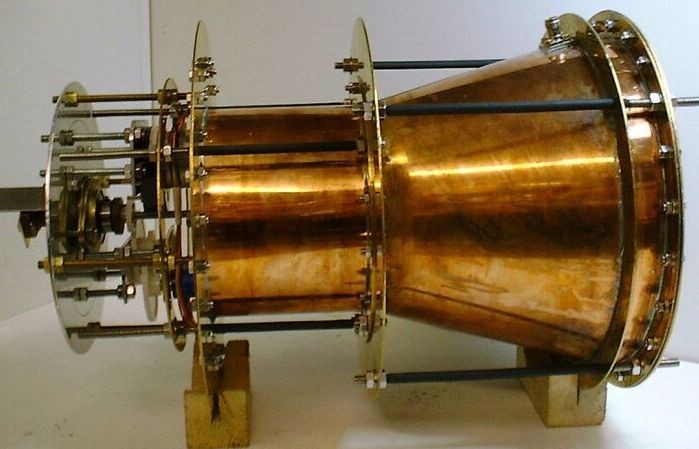NASA’s peer-reviewed paper on the revolutionary Electromagnetic Drive— colloquially known as the EM Drive—has finally arrived, and it’s created quite a stir in the scientific community.
NASA’s Eagleworks Laboratory, the group that tested the EM Drive, released evidence claiming the EM Drive really does work, challenging Newton’s third law in the process.
“It’s an interesting story in that it seems to be an inexplicable technology development; nobody can really explain why it works,” said Tom Jones, former NASA astronaut and UA alumnus.
RELATED: UA researchers explore polar wander on Pluto
The EM Drive is a propulsion system which produces 1.2 millinewtons of force for every kilowatt of thrust. Propulsion normally works in concordance with Newton’s third law, meaning that for every action there is a reaction, said physicist Giorgio Torrieri, UA Ph.D. holder and professor at the State University of Campinas in Brazil.
For example, a rocket expels exhaust in order to travel upwards. But this isn’t the case with the EM Drive.
“What [the researchers] claim they have found is movement without a reaction,” Torrieri said. “They found that with [applying electromagnetic radiation to a chamber of] a particular sort of shape, you get a movement without needing to burn any fuel. This violates conservation of energy and conservation of movement.”
According to Torrieri, the electromagnetic propulsion aspect of the EM Drive is not what causes it to defy the laws of physics. While electromagnetic propulsion may not be uncommon, the downside is it produces a small reaction and acceleration, making it much weaker than chemical-fueled rockets, Torrieri said.
Propulsion systems can be ranked based on efficiency, starting with chemical propellant, moving on to more efficient electrical propulsion and ending with nuclear electric propulsion, Jones said. The EM Drive falls under a more exotic category, alongside systems such as solar sails and magnetohydrodynamic propulsion.
“Assuming [the EM Drive] actually proves to be physically possible, it would fall into the category of a very efficient engine that could be used for very low thrust attitude control,” Jones said.
Torrieri explained that, while the EM Drive may not need propellant, the amount of thrust it produces is very small. Though this may mean the thrust is weaker, the proposed electromagnetic propulsion could run for months. “You wouldn’t be able to leave Earth, but if you start from space, you’d be able to accelerate to very high velocities because you’re constantly accelerating.”
While this low level of thrust may not be able to send humans to the Moon, it could potentially be used for a communications satellite, reconnaissance satellite or weather satellite, Jones said. The drive’s ability to stay on for long periods of time could also open up areas of the outer solar system that were previously out of reach for chemical-propelled rockets.
“This engine might fit into robot spacecraft powering around the inner solar system, to go and explore the planets,” Jones said. “And then if we develop a nuclear power source for use in orbit in space, then you could take that same technology and apply it to the outer solar system.”
In addition to thrust, energy efficiency is another issue to take into account when thinking about space travel.
“The biggest drawback seems to be that it eats up a lot of electricity for not a lot of thrust, and when you’re dealing with spacecraft powered by solar panels, electricity is not easy to come by,” Jones said. “So at this point, the demand seems to be a more robust power system.”
According to Jones, the key to developing this power system is nuclear power. And while nuclear propulsion has long since been a proposed route for space exploration, NASA is hesitant to experiment with it. Both the cost of development and the fact that the reactors would have to be tested here on Earth has caused NASA to be very reluctant in pursuing this, Jones said.
RELATED: UA scientists discover water on metal asteroid
“Maybe the developers will be able to make this more efficient in terms of power and more productive in terms of thrust,” Jones said. “Then over time they’ll develop a more practical engine that might be able to deal with larger spacecraft masses and real mission profile needs.”
Torrieri explained that from a physics perspective, scaling up the EM Drive so that it could power larger human-sized spacecraft is not the priority.
“I would say that before talking about spacecraft, one has to really make sure beyond reasonable doubt that this isn’t an experimental error, which it very likely is,” Torrieri said. “Physicists should be focused on finding every possible explanation for why this could occur without violating the laws of physics.”
Both Torrieri and Jones agree that the EM Drive needs to be tested further before its efficacy can be determined.
“There are these people who claim they see an effect, but considering how revolutionary it is, you need amazing evidence, and at the moment I don’t think this evidence is there,” Torrieri said. “Extraordinary claims require extraordinary measures.”
Jones remains more optimistic. “If this thing goes from a crude, experimental device to something practical in 20 or 30 years, even 10 years, then we might revolutionize the way we can explore the solar system.”
For more information on UA alumnus Tom Jones’ experiences in outer space, check out his latest book, “Ask the Astronaut.” You can also find the original EM Drive paper published by NASA here.
Follow Hannah Dahl on Twitter.









